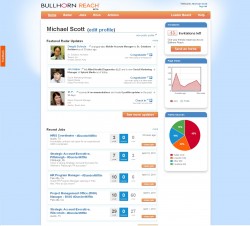 A new– and for now, free — toolset from Bullhorn is getting good marks from users who have been testing it for a few months, but what’s most impressive is that it can give recruiters an early heads-up about their connections who may be preparing to “go active.”
A new– and for now, free — toolset from Bullhorn is getting good marks from users who have been testing it for a few months, but what’s most impressive is that it can give recruiters an early heads-up about their connections who may be preparing to “go active.”
KC Carpenter, a healthcare recruiter and co-founder of K.A. Recruiting in Boston, says the still-in-beta Bullhorn Reach is “great. It’s a huge, huge time saver for us … What would take 10 times as long, we can do with one click.”
If automating postings to social networks and optimizing them for search engines was all the service did, “it would definitely be a site I would pay for,” he says. But Radar, the tool that tips you to the likelihood one of your connections may be starting an active job hunt, is something Carpenter sees a “great for business development.”
Like the updates LinkedIn sends out, Bullhorn Reach keeps tabs on important changes made to their profiles by your connections. You get notified when the algorithms decide that the changes and frequency are suggestive of someone preparing to job hunt.
 “That’s the secret sauce,” jokes Bullhorn CEO and co-founder Art Pappas, who won’t disclose the artificial intelligence behind the analysis. However, the program does routinely and quickly what recruiters and sourcers do manually.
“That’s the secret sauce,” jokes Bullhorn CEO and co-founder Art Pappas, who won’t disclose the artificial intelligence behind the analysis. However, the program does routinely and quickly what recruiters and sourcers do manually.
Like recruiters, the program looks at updates, their frequency, their nature, and takes into account their timing. It analyzes “aberrations in behavior,” Pappas says, and it gets “smarter” over time.
Kim Hollenshead, a recruiter with publicly-held IT firm VMWare, Bullhorn Reach gives her online presence more currency, because she can update jobs and content quickly, and the landing pages created by its SEO component, makes it all more visible.
Radar, though, gives her “real impact,” she says. “On my front page (the Bullhorn Reach dashboard), I see what things are happening. I can send them a note,” congratulating her contacts on promotions or job changes.
It’s a way, she adds, “to check-in to see what they are doing.”
Reach’s core tools will be familiar to any recruiter who’s used Jobvite, Jobmagic, or one of the higher-end talent acquisition systems.
There’s one-click posting of jobs and content to Facebook, Twitter, and LinkedIn. There’s an SEO component that creates landing pages, and a basic keyword match to give you a list of network connections who might be a fit for each job. Some limited editorial is available in a library, compiled by bots that seem set to focus on articles about recruiting and staffing. Reposting can be automated, to keep jobs from getting lost in the tweet stream.
“The core of what we are doing is to make sense of social media for recruiters.” For Bullhorn’s market — staffing agencies and 3rd party recruiters — time is money in a very literal sense. Recruiters have limited time to participate in the conversations that are the hallmarks of social media, but that doesn’t mean they don’t want to, Pappas says.
“How do I get in the conversation?” is as much a concern for agency recruiters as it is for corporate recruiters, Pappas notes, adding one of the primary design objectives was to make it “zero training.”
No question about that. Bullhorn Reach is about as easy to use as any tool out there. The larger your network, the more efficient it can make you.
Since it is in beta, not everything is yet in place. The Facebook connection is still being finessed. And the article library is available only to 3rd party recruiters. Pappas says the algorithms are also being tweaked and the feature set will be enhanced, based on the feedback the company is getting from users.